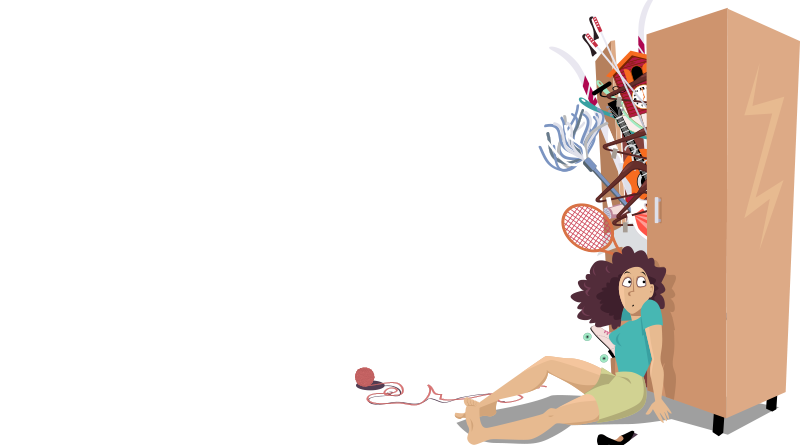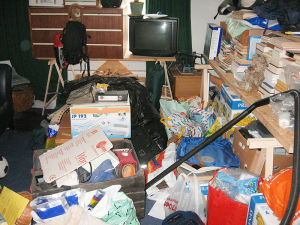It’s Complicated
Decluttering can be a challenge for those at middle age and beyond — but there are ways to achieve it
By Margaret McCormick
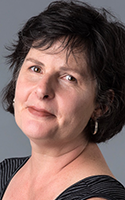
Stuff happens. We accumulate it little by little over the years — enough to fill a house and sometimes a house, a vacation home and a storage unit: newspapers and magazines, tax returns from 25 years ago, clothing that suits our former work lives, books waiting to be read, thoughtful gifts, unwrapped but never used. The list grows — and the stuff fills our closets, cupboards, shelves, cars, dressers and desks.
We know that “less is more,” but we tend not to live that way. We see tidy, spare living spaces on TV, on Pinterest and in the pages of magazines and wonder how people achieve such zen. Were they born that way? Clutter is consuming and weighs on us physically, mentally and emotionally.
But how do we break free from it?
Decluttering one’s life at middle age and beyond is complicated, says Carrie Luteran, a professional organizer based in Central New York. Often, several things are at play. As we age, women and men often desire to downsize their belongings — while also, perhaps, storing things that belong to their children and dealing with the stuff their parents have left behind and that their children don’t want. It can feel extremely overwhelming.
As we begin a new year with a fresh start and clean slate mindset, Luteran suggests a simple exercise. Do a little self-reflection and ask yourself some questions: Who are you? Where are you in your life? Where do you want your life to be in a year? Visualize it. How can you get there?
“We hang onto a lot of things from the past and it’s not really positive,’’ says Luteran, who owns and operates Pretty Neat Solutions, a home organization and interior design solutions business. “Certainly keeping some sentimental things is important. But if you are hanging onto a hobby from 10 years ago, that might be keeping you from developing a new hobby. Think about your life now and what’s next for you. Think about getting rid of things.’’
You might be asking yourself, “why is this so hard?’’ And you wouldn’t be alone.
Nicole Christina, a Syracuse-based psychotherapist with a focus on positive aging, says decluttering/downsizing for the next chapter of life is challenging because our stuff carries emotional weight — especially sentimental and inherited things, like a grandmother’s fur coat or china service for 12. Even if you will never wear the coat or set a table with the china, letting go of such items can cause anxiety and feelings of guilt.
“If decluttering was so easy people would have all their stuff in clear Rubbermaid totes, alphabetically organized,’’ Christina says. “It isn’t easy. There can be some grief in saying, ‘I don’t need this anymore. It’s part of my past.’ There can be some melancholy and bittersweet feelings in getting to the next stage. You may cry. But there is also an amazing payoff.’’
In the words of Japanese organizing consultant and sensation Marie Kondo: “When we reduce what we own and ‘detox’ our house, it has a detox effect on our bodies as well. What is important when tidying is not to get rid of everything, but to keep the amount you need and spark joy.’’
Where to start – and how?
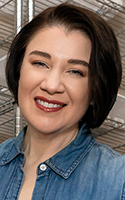
You might be inclined to start in the basement or attic, where you have been socking things away for decades. But that could be daunting. Luteran recommends starting in a more manageable place, like closets and kitchen cupboards. “It’s best to start in a relatively easy place, so you see some progress,’’ Luteran says. “Just start chipping away at it. You get better as you do it.
“Don’t start with the things that are the most sentimental,’’ she adds. “Those are the hardest. Work up to it.’’
Process/methods
Use boxes marked “save,’’ “donate/sell’’ and “discard.’’ Be honest and be relentless. If you haven’t used or worn something in a year or more, purge it. If you don’t have the time and energy to hold a yard/house sale or sell things on Craigslist and eBay, donate it. Think of your mission as keeping things that serve you now rather than getting rid of everything.
“Ask yourself, ‘when is the last time I used this? Does it bring value to my life? Do I love it? Do I really need it?’ If you can look at your own stuff with a little distance, it can help you get over the hump,’’ Luteran says.
One of Luteran’s favorite approaches to beating back clutter is what she calls the 5-5-30 process. Take five minutes a day to select five items to get rid of. Repeat for 30 days. At the end, you will have purged 150 items.
Schedule specific time
Set specific time or times to dedicate to decluttering/downsizing. “Give yourself a break,’’ Luteran says. “You accumulated this stuff over many years; you’re not going to get rid of it all in a weekend. I encourage people to set appointments. Schedule a time and say, ‘I’m going to do this for two hours and then get away from it.’ ’’
Take action before a move, not after, and if possible, don’t wait until an emergency situation (say the death of a parent and quick sale of a home) to pare things down. If you are downsizing from a house to an apartment and know you are going to have half as many kitchen cupboards and closets and half as much overall space, trim your stuff accordingly.
Preventive maintenance
Spend a few minutes each evening doing a clutter sweep of your living space, Luteran suggests. This includes things as basic as picking up newspapers and magazines, putting mail away and clearing items from kitchen counters.
If you’ve been a champion collector of clothes, books and tchotchkes, adopt a “one in, one out’’ policy. For anything new you bring home, something must go.
The KonMari Method of Decluttering
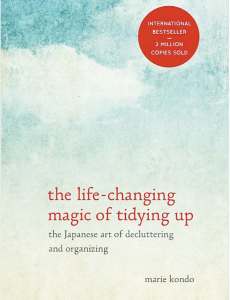 Organizing consultant Marie Kondo is the author of “The Life-Changing Magic of Tidying Up: the Japanese Art of Decluttering and Organizing.’’ The book has become something of a cultural phenomenon. Despite its title, Kondo’s approach to decluttering advocates paring down possessions in one fell swoop, rather than in steps or stages.
Organizing consultant Marie Kondo is the author of “The Life-Changing Magic of Tidying Up: the Japanese Art of Decluttering and Organizing.’’ The book has become something of a cultural phenomenon. Despite its title, Kondo’s approach to decluttering advocates paring down possessions in one fell swoop, rather than in steps or stages.
That approach might be too extreme for some, but Kondo believes that discarding must precede organizing — and that both bring joy. The KonMari method of discarding begins with clothes, followed by books, papers, miscellany and mementos.
Kondo and her book have inspired a new Netflix series, “Tidying Up with Marie Kondo.’’ In the series, Kondo helps people swimming in too much stuff eliminate clutter and choose joy.
New Year, New Opportunities to Declutter
Professional organizer Carrie Luteran is offering a three-session class, “Declutter and Keep Your Home Organized,’’ through OCM BOCES in February. The classes will be held 6:30 to 8 p.m. Feb. 12, Feb. 19 and Feb. 26. Fee: $59. To register, go to www.ocmboces.org/adulted
For more information on Luteran and her organization and design services, visit www.prettyneatsolutions.com
Psychotherapist Nicole Christina is the host of the “Zestful Aging’’ podcast and offers “Zestful Aging’’ webinars and online courses. For more information on Christina and her services, visit www.nicolechristina.com
Luteran and Christina are collaborating on an online course that focuses on decluttering in middle age and beyond and hope to have it available in March. Check their websites for more information.

